September ended with a splash! The long drought of summer was definitively ended by increasingly heavy rain and by the 30th, last day of the trout season in our part of the world, practically all local rivers were in muddy flood. Baulked from any local fishing possibilities, David Burren and I drove over to Heale in Wiltshire to find the Avon was perfectly clear and actually quite low. Of course there were showers here too and the wind was certainly annoying. Incidentally, I have often wondered why chalk stream writers of the past complained so often about contrary winds. We have winds on our border streams too and we seem to manage. I think the difference is that our local river valleys are tight and wooded and afford some sort of protection. The valleys which divide the chalk downs of southern England, particularly those on Salisbury Plain, are much shallower, more open and exposed to the elements.
Anyway, David and I wrapped up in waterproofs and fished on through the gusts to take 32 fish between us by five o’clock. Some 8 or 9 of them were modest grayling; the rest were trout up to a best fish of 21 inches. Interestingly, every single one was taken with a size 16 Grayling Steel Blue dry fly. I can’t praise that simple little pattern enough; it seems to work everywhere in the autumn when the willow flies and pale wateries are about. A client was using it the other day to catch rainbows in a lake.
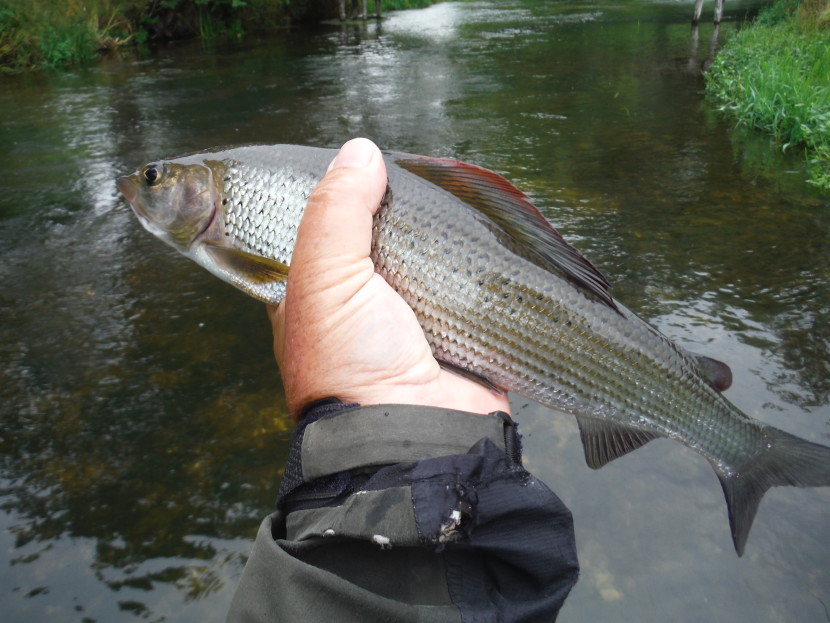 Avon carrier grayling
Avon carrier grayling 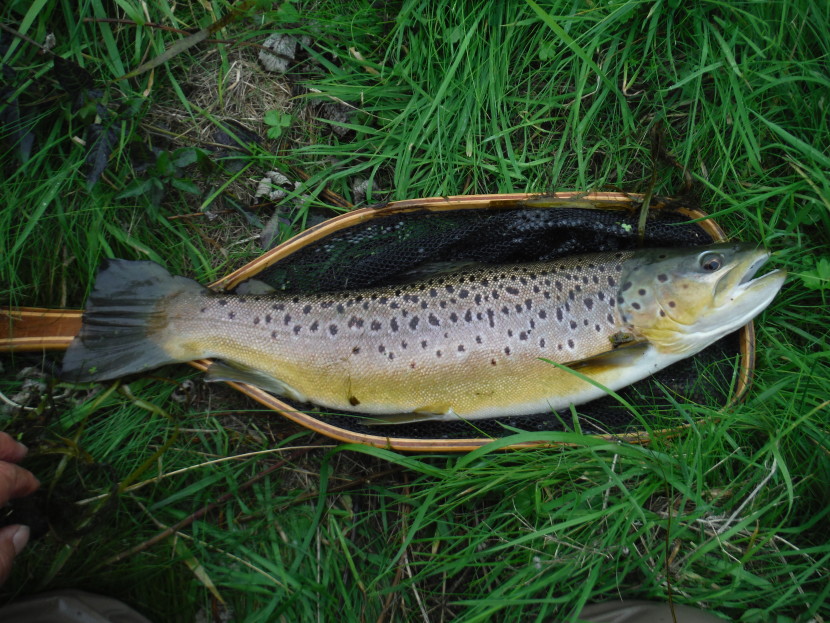 Avon trout on the last day of the season
Avon trout on the last day of the season A couple of days later I was out with client Francis Rundall at Llangoed and Lower Llanstephan on the upper Wye. I was hoping we had found a brief window in the high water conditions with 2ft 3 inches showing on the Llanstephan gauge, but less colour than I had originally feared. The rain came down hard as we fished and the river rose and coloured further a few hours later, but not before Francis experienced a long draw on the Abacus Tube he was working across the tail of Dolmeudwy on a fast sink tip. In salmon fishing during these difficult times, it is funny how when the take eventually happens the reaction is mainly one of surprise. It was a pretty little hen of only 29 inches, which nevertheless dropped back to Orchard Pool and caused me a lot of trouble to net in very fast water. The pair of us ended up thoroughly soaked! Tim Hughes came down afterwards and had a nice cock fish of about 15 pounds from the same beat, while EB from Shrewsbury had another hen of about 10 pounds from Abernant at about the same time. Meanwhile, from RK of London, who was booked on the Rectory, came a most unusual report. There is a certain insouciance about it, appropriate to a salmon angler in these uncertain times, so I’m going to quote the whole thing:
“… difficult return to fill in. Set the clock for 5.30. Woke up at 4.30 then slept through the alarm and got up at 7. By the time I left it was 8am. Then "Insulate Britain" decided to demonstrate on the A40 at Hanger Lane so delayed there for 1.5 hours. I sympathise, indeed support them, but just not when it affects my fishing. Finally hit the M4 at around 10.00am to be met by one set of roadworks after another. Eventually got to Usk around 12.30 and thought "bugger it" I'll have a quick throw on the lower Usk first before pressing on to the Rectory. Third cast I had an 11lb hen. 30 minutes later a 13lb cock fish. Fished on for a couple of hours but no further takes and the river rose. By then it was too late to go to the Rectory but, hey ho, mission accomplished. Even managed to fill up with diesel in Wales which is like gold dust in London. So I caught two Salmon, not at the Rectory, but because of the Rectory and at least it was on a WUF river.”
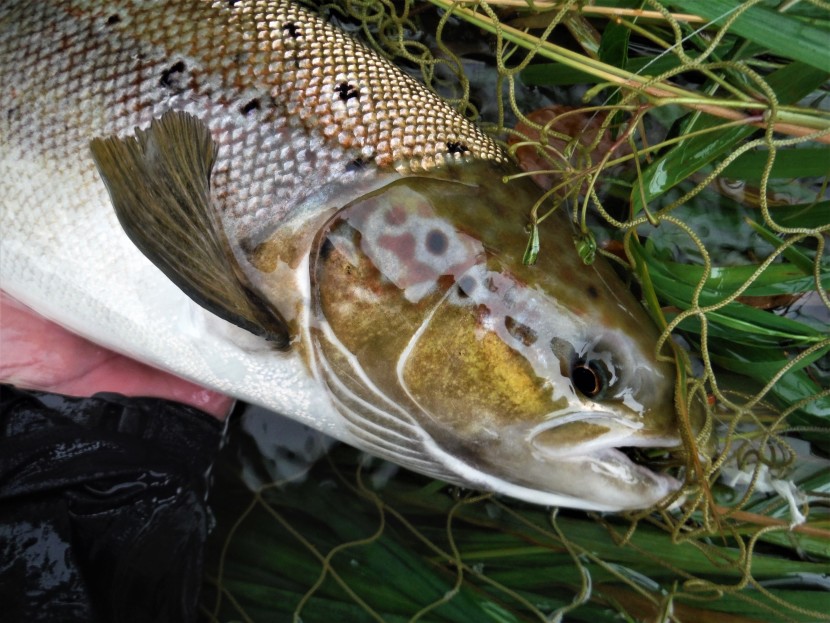 Harvest salmon for Francis Rundall
Harvest salmon for Francis Rundall 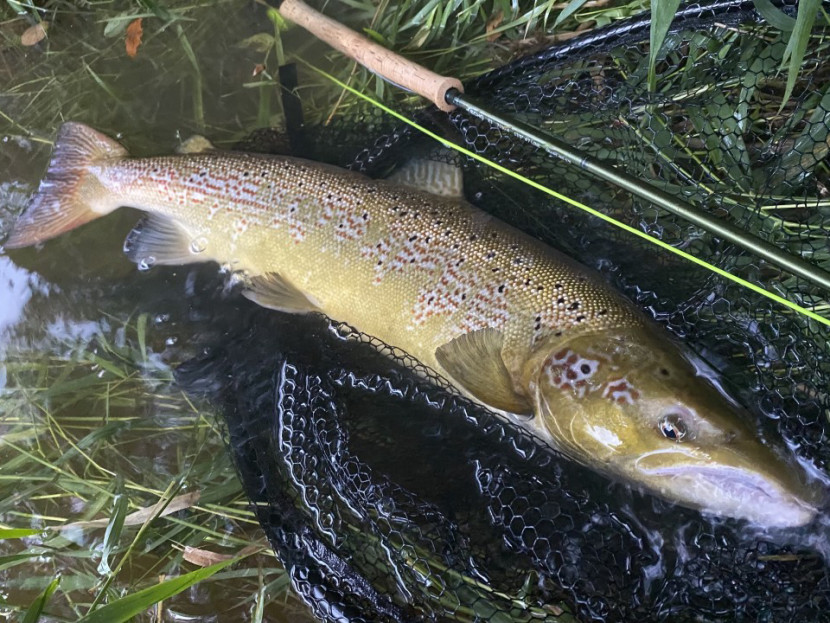 Cock fish from the Orchard Pool - TH from Brecon
Cock fish from the Orchard Pool - TH from Brecon 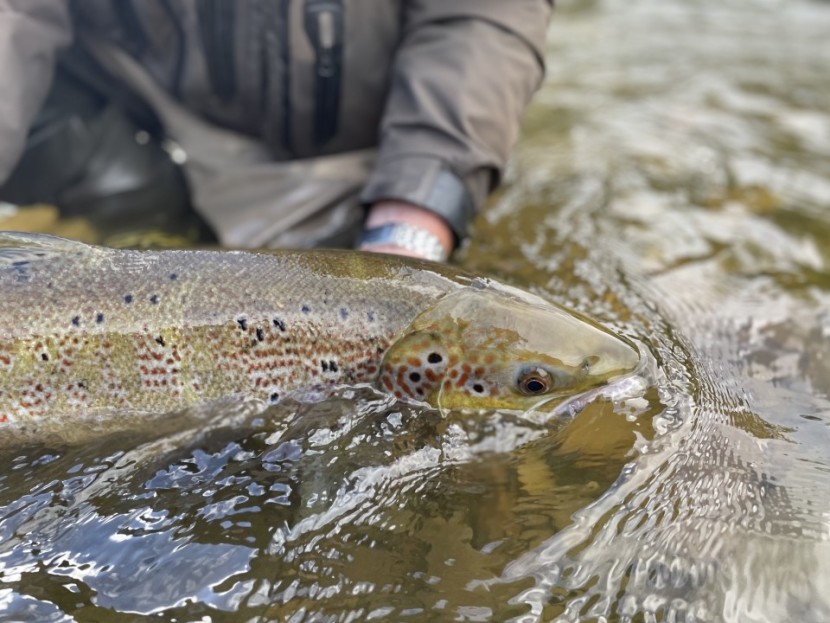 Abernant salmon - EB from Shrewsbury
Abernant salmon - EB from Shrewsbury 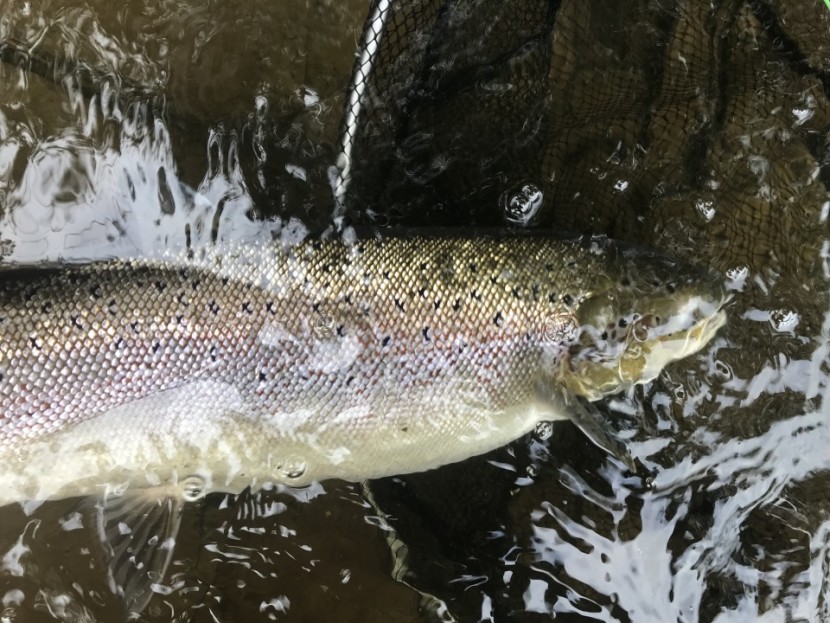 Llangoed salmon - MH from Swansea
Llangoed salmon - MH from Swansea By the 9th as levels dropped again, there was a rush of salmon reports from the top end of the Wye, too many to show here. “A late flourish,” as one reporter described it. I read reports of fish from many of the familiar pools in the Erwood area, including some which looked relatively fresh. As high pressure took charge with the weather warm, although cloudy as often as sunny, we were beginning to experience some classic autumn fishing with colour in the leaves and the river looking at its best. The water level was now steadily dropping on the salmon beats, although the colour remained for a surprisingly long time on the lower river.
Before long the grayling fishing also began to impress. There were difficult days as always, but also some good catches. Let’s get back on to the regular trout and grayling reports. LB from Bath found the Lugg at Lyepole extremely muddy when he fished on the 2nd, but took 9 grayling on various nymphs – including something called a Squirminator! Whatever that is, I’m sure it’s allowable in such prevailing circumstances. DH from Horsham fishing at Sugwas on the 6th caught a rare Wye sea trout on luncheon meat along with 3 barbel and a chub. Trout were still in season on the Bideford Brook, a Severn tributary, and TL from Greet (Birmingham I think) took 5 of them using a Royal Coachman dry fly and a Prince Nymph. This seems a very American approach regarding patterns, but the Gloucestershire trout also seemed happy with the flies offered!
Seth from the Foundation had just 3 grayling from the upper Irfon at Cildu, one of them being a beautiful specimen of just under 2 pounds – see the photograph. On the 10th AM from Dorridge caught 20 grayling at Lypole, using both nymphs and dry flies. A day later TM from Somerset had a real red-letter day at Cefnllysgwynne on the Irfon, catching no less than 62 grayling including some good ones, using variously French leader, duo and dry fly. He noted that there were rising fish in most of the slower pools, had a close encounter with a young otter and enjoyed the autumn leaves in their brightest colours. ST from Salisbury was also at Cefnllysgwynne on the same day, used dry flies only and caught half a dozen grayling to a very impressive 2.5 pounds. JJ from Stourbridge with a friend fished Lyepole on the 13th and caught 34 grayling between them on nymphs. GP from Chertsey with a friend were at Abernant on the main river and accounted for 20 grayling with Euro-nymphing methods. On the 15th AP from Wirral took 15 at Lyepole using the Duo system.
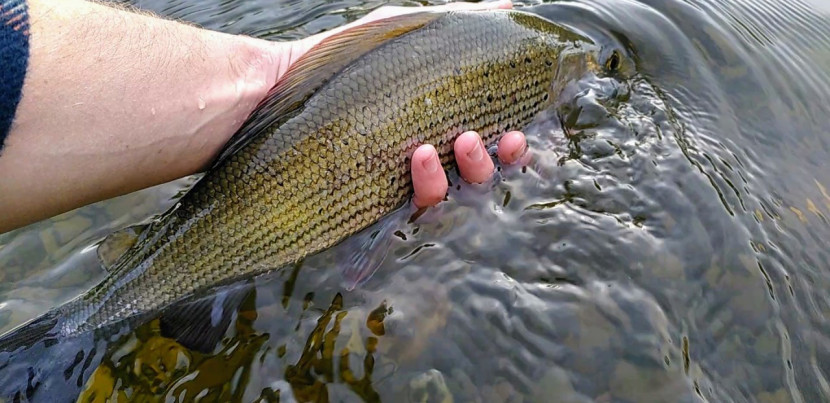 Cefnllysgwynne grayling - TM from Somerset
Cefnllysgwynne grayling - TM from Somerset 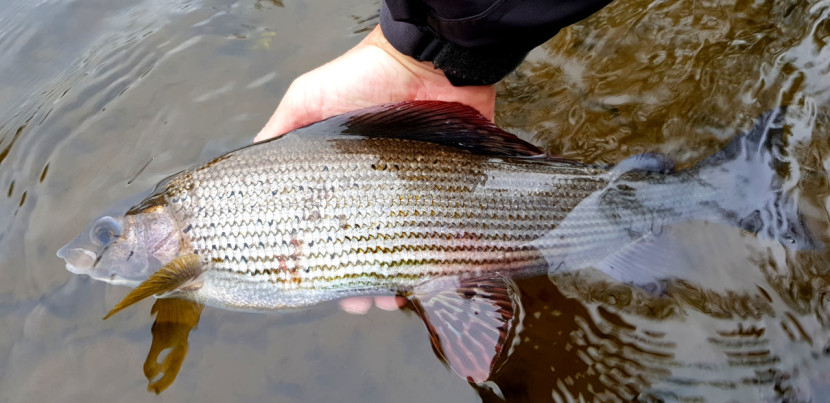 Cildu grayling - SJ from Herefordshire
Cildu grayling - SJ from Herefordshire MB from Abergavenny was fishing at the Rectory on the 17th, last day of the salmon season, when paddle boarders entered the river at Boughrood Bridge. When he remonstrated with them for the trespass, they threatened him with violence. That is depressing to hear about, but I’m afraid is what it has come to in some cases. I can only suggest that anglers be firm, but polite when hailing canoeists who shouldn’t be there, and if the trespassers show that kind of unpleasantness…well, let it go. I don’t know about you, but I certainly don’t want to spoil one of my precious days on the river arguing with people who behave like that. AG from Harleston in Norfolk was back on the 18th. This time he fished the Dee at Glyndwr Preserve, the river being low and clear, and got 12 grayling to 15 inches on nymphs.
Heavy rain on the 19th came back to interrupt what had been very pleasant autumn fishing at times and the rivers rose in flood again. Every autumn there seems to be a turning point and this was it, with a damp and fresh to the air now and the leaves falling fast. A heavy freight of leaves twisting and turning in the current can drive you almost insane when fishing wet with three flies, although the grayling don’t seem to mind. Never try to cast a leaf off; it will spin like a propeller and kink the leader. High water stopped play for a while although the Irfon was fishable at times. I fished the Cammarch Hotel waters on a day of sunshine and showers and managed to get underneath the gliding leaves by using three weighted wet flies and a sinking leader butt. Grayling bites from just above the bottom came as long, hard pulls, but surface rises in the peat-coloured waters were not to be seen. KP from Aylesbury fished the little river at Abbeydore on the 24th and caught what he told us were his very first grayling, four of them, on nymphs. That is an event worth recording. I can remember catching my very first grayling, admittedly a long time ago. This came from Surrey’s River Wey, in an eddy below Somerset Bridge, and I’m afraid I caught it with a small worm below a quill float. I sincerely hope grayling still live there although the flow of that little river has dwindled during more than half a century of abstractions.
Drizzling rain continued on a daily basis and kept the rivers high. I was out with a client at Craig Llyn on the 28th in very high water, coloured with a peaty stain and containing a sort of soup of twisting leaves. The rain fell all through the day. Still, there were a few fish to be had and while messing around with a spare rod and wet flies I briefly hooked and then lost one of the largest grayling I have seen. After which the rain came on really hard, side streams began to pour in mud and by that evening everything was in flood and would obviously remain so for days to come. In conclusion, October was warm (not a frost seen through the month) and gave us a few nice grayling days, but the rain ensured there were not too many of them. Finally, 2021 was not a good year for the salmon with just 315 fish recorded for the river. Much discussion is ongoing as you might expect, but more about that next month.
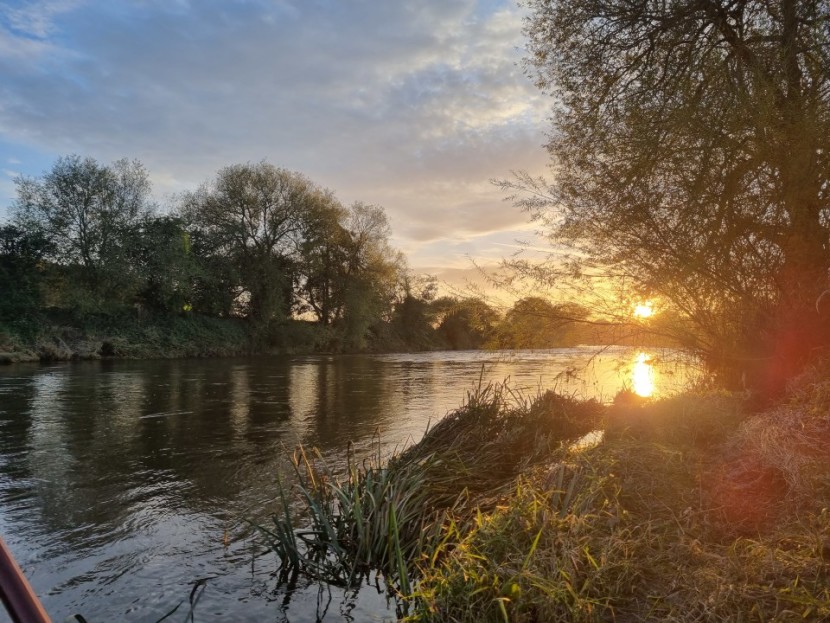 Foy Bridge - MH from Wolverhampton
Foy Bridge - MH from Wolverhampton 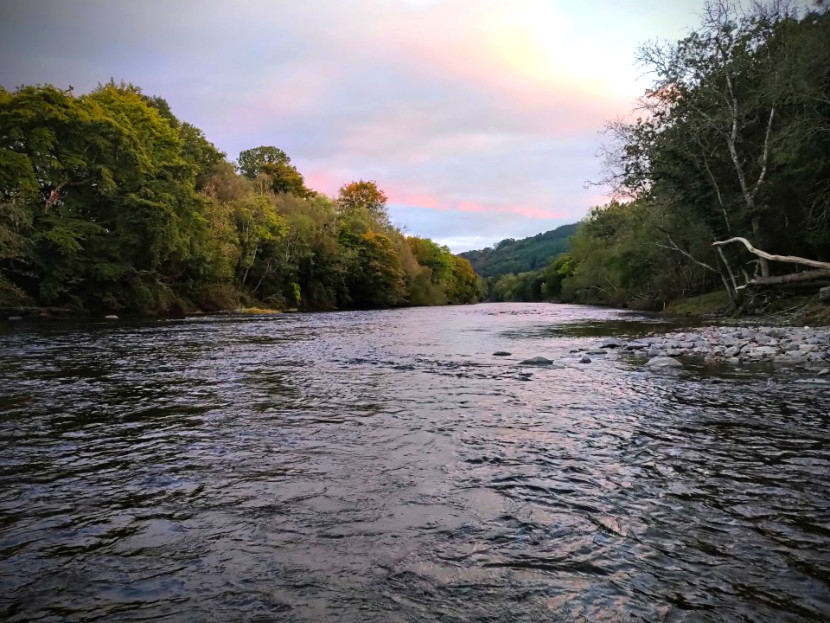 Lower Llanstephan - JM from Bristol
Lower Llanstephan - JM from Bristol 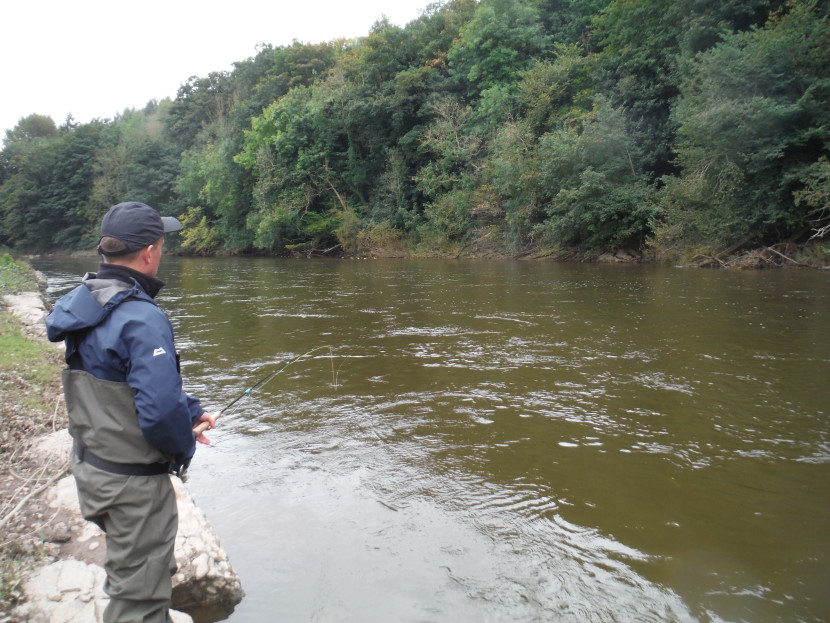 Last days of the salmon season
Last days of the salmon season The more I fish, the fussier I get about tippet material. Some people aren’t and will tie their flies to any old stuff, but they are doing themselves a disservice. The tippet is the deliberately planned weakest link between angler and hook and once the hook is set in the jaw of a fish, it can turn out that everything depends on it, whether the tussle is to end in triumph or disaster. More than that, the nature of the tippet determines how the fly will fish and very likely whether a fish will take the fly in the first place. After World War II when the first nylon arrived in the UK from France under the Racine Tortue name, it wasn’t very reliable stuff. Better products quickly joined it from Germany and the UK and the old silkworm gut in use until that time was soon redundant. Today the market is all a bit confusing with three different types of monofilament on offer: old-fashioned nylon, and the newer fluorocarbon and co-polymer variants.
I have written about monofilaments before (see October 2015 newsletter), but I think there is a case for revisiting the subject and adding some points. Leaving salmon and sea trout aside, I need monofilament for 5 main tasks:
1. As dry fly tippet, to float upon the surface.
2. To make up wet fly leaders with droppers to fish just below the surface.
3. To present heavy nymphs to run along the bottom of the river
4. Late in the winter to trot a float and maggot bait up to 100 yards for grayling.
5. As a fine but strong leader material in different thicknesses to present both lures and nymphs to suspicious rainbows in clear pools.
Dry fly tippet: I have experimented over the years with quite a few brands, more recently with copolymer because it is designed to float. Monofilament tippet for a dry fly should obviously not be too thick, but it would be a mistake to simply choose material with the highest breaking strains in thin diameters. More important is that the material is naturally limp, so that it lies softly on the surface without developing prominent wire-like coils. The diameter needs to match the hook size, so I would suggest 6X for size 18 or 20 hooks, 5X for 14 and 16 hooks, and 4X for size 10 and 12 mayfly hooks. This matching of hook size to tippet should minimise undue twisting of the monofilament or – much worse – nasty events such as breaking off on the strike. See previous article on the subject of the X system for measuring monofilament diameter. I keep spools of 2X and 3X which are used on occasion for making up tapered leaders. Frankly, I have little or no use for 7X or 8X tippet, although it is available. The best material I have found to date, by quite a good margin, is called Stroft GTM and is manufactured in Germany. For some reason the main game fishing stores don’t seem to keep it, but you can find it on the internet and Angling Active certainly have it.
Wet fly tippet and multi-fly leaders: In this case I have no hesitation in recommending an old-fashioned nylon called Bayer Perlon, made in South Germany and now marketed by Kamasan. Again, the game fishing stores don’t seem to keep it, but many coarse fishing shops do. This will float if it is greased (but you don’t want that for fishing wet flies) or sink if it is degreased, but its main characteristic is that it is slightly flexible, just stiff enough so that the droppers don’t tangle too easily, and extremely reliable when knotted. Over time I have successfully played to the bank quite a few accidental salmon on the 3.2 pounds breaking strain variant (although of course it would be irresponsible to deliberately fish so fine for a heavy fish). Be aware, however, that like all old-fashioned nylons it does weaken with age and particularly if exposed to sunlight. After about 5 years the finer sizes suddenly become like rotten cotton. Mark your spools with the date of arrival, keep them in the dark, and test them with a tug now and then. Discard anything which seems weak.
For presenting a team of heavy nymphs “European-style” under the rod top: In this case, you need to construct a leader which is fine enough to cut through the surface current without creating excessive drag, but also as strong as possible. For this kind of fishing a straight-through leader of a single thickness is usually used for all the sub-surface fishing. Flexibility is a virtue of course, but as the rod top itself is very thin and sensitive, breakages playing fish are usually avoided even at close quarters. I tend to make a choice about thickness depending on the number of snags in the river bed concerned, but I go as fine as I dare. Like others, I like Stroft for this job and in this case the Stroft ABR (abrasion resistant) variant is best. This will put up with a certain amount of dragging over stones which would damage softer nylons. So far in this survey, the German manufacturers have been doing rather well, haven’t they?
Trotting a float: For fine trotting you need a simple monofilament nylon of about 3 pounds breaking strain. Heavier material tends to get caught by wind and current and so drag the float off-line. I used to be quite happy to use Bayer Perlon for this, but you did have to grease it for a long distance to keep it on the surface, sometimes twice in the day. Now you can avoid that chore by buying a float fishing nylon which is designed to float: Drennan 3.2 pounds float fishing nylon is the one I use, available at my local tackle shop.
Rainbow trout: There are fish which I don’t believe are particularly nylon-shy – salmon, for example, and sea trout at night – but that list would not include rainbow trout in clear water pools. For this reason I tend to use fluorocarbon, which manufacturers used to claim is invisible to fish because it has a refraction index close to that of water. I don’t believe that claim for a moment, having watched spooky rainbows in catch and release pools approaching the fly only to shear off at the last moment until the tippet diameter was reduced to dangerously fine levels. However, in this case fluorocarbon does seem to have an edge over ordinary nylon. It is expensive stuff, but it has the advantage of not deteriorating with age. However long it takes, you will be able to use the spool up. The one I like is Riverge Grand Max, which is made by Kureha of Japan, and 6X, 5X and 4X are the diameters I find most useful.
I will make a few other simple points. These might seem like points for beginners, but some of us are beginners and we all were once. When finishing for the day, do you wind the whole leader back on to the reel, tippet and all? If you do so, be very careful to tease out the fine end of the tippet when you use the reel again, in such a way that the line winds off properly without one coil trapping under another. Also, don’t pull hard on the tippet end to get the reel to unwind, because fine nylon can cut into plastic fly line and damage it. A safer idea is to have either a metal mini-ring or a loop at the end of the tapered section of your leader and to discard the tippet at the end of one fishing day and tie on a new one at the beginning of the next. The tapered part itself will be easier to find and unwind than fine nylon. Alternatively, if you have a carefully made up leader needle-knotted to the line as on my favourite Model Perfect trout reel, when finishing the day you wind the line itself onto the spool, but then wind the long leader round the outside of the reel pillars. Just don’t turn the reel until you are ready to fish again with the leader taken off the pillar and fed out through the rod rings.
It’s almost always a good idea when winding a fly line in, to use one or two fingers of your rod-holding hand to feed the line evenly back and forth across the spool as it comes in. This is particularly important with wide spools. If the line bunches up on one side, a loose loop can slip over the rest and cause a jam. You don’t want to find out about that on the next fishing trip when you are into a big fish. Hugh Falkus wisely advised his readers before a sea trout fishing night to strip the whole line off the reel across a field and carefully wind it in evenly.
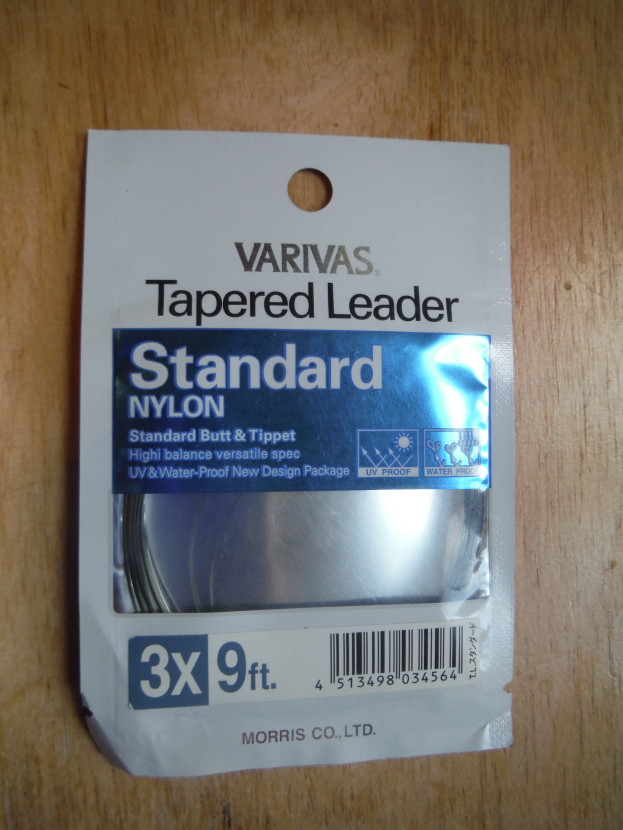 Varivas leaders
Varivas leaders Similarly, if you are long trotting for grayling with a centre pin, pick one with a narrow spool and watch carefully that the incoming line doesn’t bunch up onto one or the other side. If it does, the nylon will probably snatch slightly when paying out. If you have one of those float rods with a cork handle and two movable rings which can fix the reel in any position, take some trouble when starting fishing to make sure the reel is perfectly in line with the butt ring. If it is out of line, you will have intermittent trouble for the rest of the day getting the line to come off cleanly. If all is in line, the nylon will wind onto the centre of the spool without extra intervention from you.
One final point is in the case you use a fixed spool reel for your trotting. A centre pin works better, but some anglers still use a fixed spool. When winding a new line onto the reel, don’t wind it off the side of the manufacturer’s spool. This will put on one unnecessary twist per turn and twists are the last thing you want in a trotting line. Instead, put the shop spool on a peg or a pencil stuck in a vice and wind the line towards you onto your reel with the spool rotating until it is empty. If you do end up with a twisted line when fishing, try to work out why. Hook links can spin coming upstream if they aren’t attached with a tiny swivel. Then take the tackle off at the far end and take the extended line on a long walk dragging behind you through a field of grass, the stems of which should take out the twists.
Incidentally and a propos of nothing in particular, I see the latest Sportfish catalogue includes Varivas tapered leaders for the first time. I have liked and used these for quite a while, but have usually had to hunt them out from the more obscure suppliers. There are several different versions, but it’s the standard tapered trout leader listed here, the one with the long green butt section, which I like. 9 feet is the only length listed, but buy the 3x version and extend it with a couple of feet of 4x, then a couple of feet of 5x copolymer, finer still if you feel you need to fish tiny hook sizes of 18 or 20, and you have a very effective and workable system to deliver your fly. The Varivas leader butt section comes with a plain end, not a loop. If you must, tie a perfection or blood bight loop, trim the tag close and squeeze your loop shut with forceps before attaching it to a braided loop on the end of the fly line. But it’s a clumsy way of doing it; much better to attach the leader butt to the fly line with a nail knot or even better a needle knot.
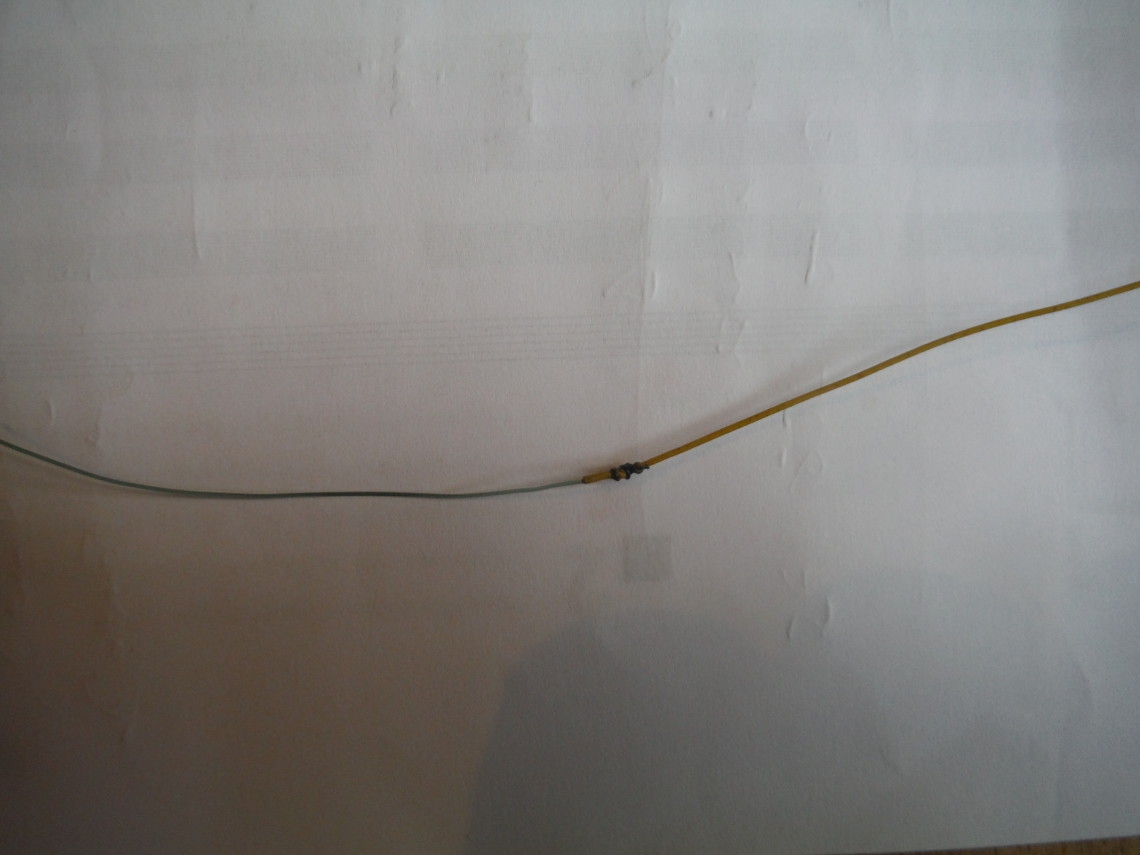 Needle knot
Needle knot Gloucestershire has its orchards, mostly along Severn-side. Back in the sixties, when I used to ride a Triumph motor cycle over to the Forest from Surrey, the trip was undertaken mainly for the pleasure of certain roads with long sweeping curves. The first was the A417, leading across the Saxon heart of England up onto the Cotswolds where the bike would be streaking between dry-stone walls, but the second was the A48 after the Gloucester city ring-road, leading now along the estuary in the direction of South Wales. That road is nearly all a 50mph speed limit now and I drive like a more sensible pensioner, but in those days with less traffic you could hear the roar of the twin exhaust pipes deepen and feel the wind pressure pull you back from the handlebars as you accelerated into each turn. There were black Gloucestershire cattle grazing in Severn-side pastures and everywhere the apple orchards. In the distance the dark hills of the Forest beckoned.
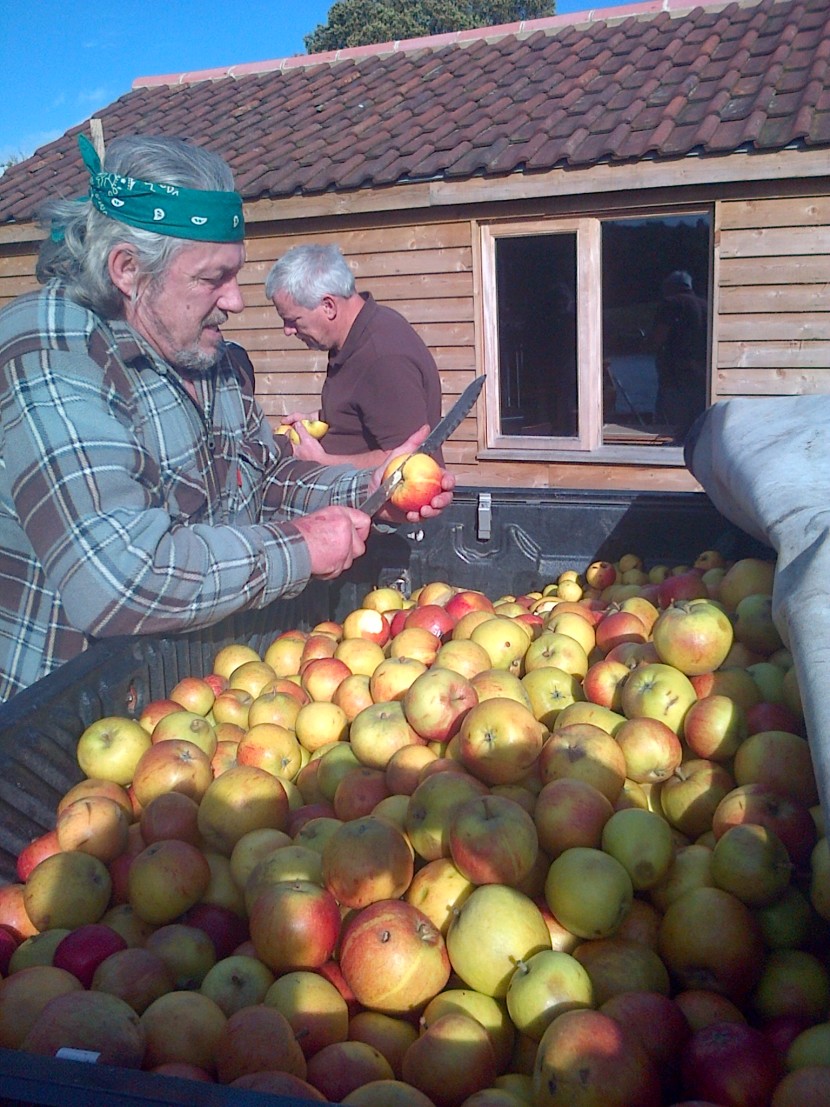 Apples should not be wasted
Apples should not be wasted Normally it’s the twin county of Herefordshire which is better known for its apples and cider making. Nevertheless, while driving up and down through the rolling lands of Hereford at this time of year, usually on the way to or from the Lugg or the Arrow, I’m often surprised to see how many of the old apple orchards don’t get harvested now. It’s been that way for a long time now. My father, who was a bit of a cider buff, and who was quite proud of the fact that he was at school in Hereford with the Bulmer brothers, would have considered this an awful waste. Why would such succulent fruit be left on the ground for the wasps and sheep to enjoy? The answer, I’m told, is that it may not match the size and colour specified by contracting brewers and supermarkets. In Eastern Europe this would never happen; individual trees virtually have people’s name on them and everything gets harvested, for making brandy if nothing else. Plums or sliva, the same simple damsons so familiar to us, fermented down in a drum, form the main ingredient, but there is a rare and prized variant made with pears. One of the pleasantest sights in Serbian communities at this time of year is the copper “happy machine” with its group of more than happy attendants, steadily dripping slivovic from a pipe as the handle is cranked. A nearby table will be spread with a confusion of glasses and a meze of smoked meat and cheese. “Come and join us, Bre! Not a drop sold until it is cold.” Such parties can go on for days. Unfortunately Her Majesty’s Customs and Excise men deny us such cheap and care-free pleasures here. We may eat, make jam or ferment but not distil, not without paying a very high tax. And the old rural crafts are neglected in these busy times. By one of our Forest streams where I regularly fish stands a tall Blakeney Red pear tree, a rare thing to see now and for certain once planted for the purpose of making perry, but nobody has collected its fruit for many years.
One man who never likes to see an opportunity wasted is Geoff, who with Rose used to run the trout fishery at Broadstone, on the edge of the Forest above Monmouth and who lives in a cottage by one of its pools. Broadstone, known for its giant projecting boulders and ancient oaks, is still a popular campsite and a carp fishery, but no longer a trout fishery, sad to say. But a few years ago it was still a local pleasure for those fly fishermen who knew it, always available when the rivers were flooded, and a good place to take rainbows on everything from tiny nymphs on a 9 foot 5 weight to an outsize Daddy floated across the main pool in the wind.
One autumn day a few years ago, when I had just finished a very enjoyable morning fishing with tiny olive nymphs, along came Geoff in his pick-up with a couple of pals and half a ton of Cox apples which had been obtained for virtually nothing. Supposedly they had been due to be discarded, although I cannot imagine why, because we all tried a sample or two and they were fresh, sharp and delicious. Anyway, Geoff had another plan for them, because he had recently acquired a cider press. This massively heavy device he had also found on his wanderings, apparently standing idle in some-one’s farmyard. Looking closely at it, I reckoned it had once been an olive press, because it had the name of an Andalusian company in the main casting along with an early 20th century date. Heaven alone knows how it reached Herefordshire from the south of Spain. We theorised that the squeezing of cakes of apples wrapped in sacking would not be much different from olives.
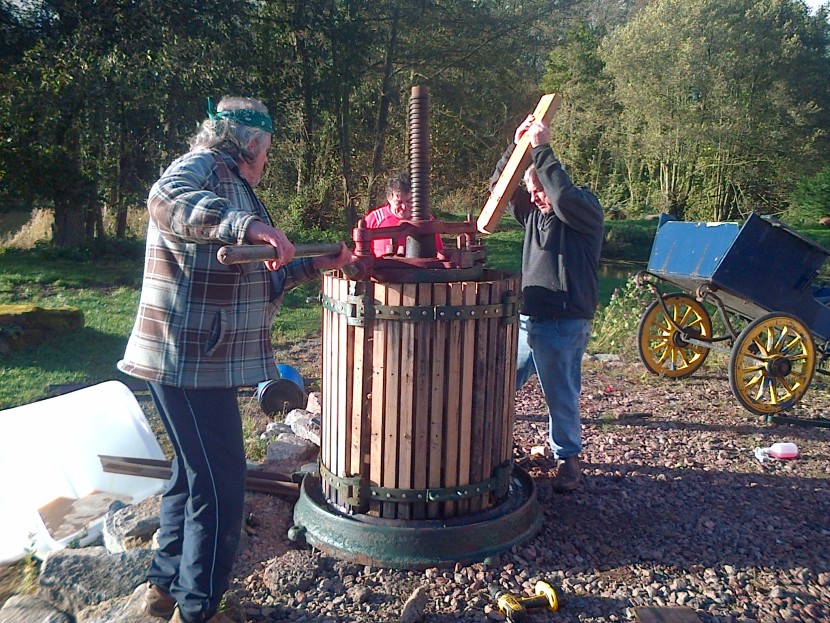 Cider pressing
Cider pressing First the apples had to be chopped up. I was reminded of that cynical Russian joke: “What uses huge amounts of fuel, pours out polluting smoke and chops apples into two pieces? Answer: a Soviet machine designed to chop apples into three pieces.” Well, we did have a two stroke apple chopping machine, another of Geoff’s acquisitions, but it soon became apparent that even when revved up and smoking it could not deal with a whole apple. Each apple fed in would have to be cut in half first, after which it would go through the machine and emerge as wet apple pulp. We set to it with knives, but believe me, half a ton is a lot of apples. We ate quite a few along the way. Next came the building of the first stack of sacks filled with apple pulp, such that the press would bear down properly on the whole pile. We had to keep adjusting the wooden staves, held in place with iron bands, all of which had come with the press.
Eventually we got it right; the double action capstan bar on top of the press was wound down steadily, and an increasing stream of brown juice began to flow from the base into the waiting plastic 20 litre containers which Geoff had lined up. Fermentation would take place inside the wooden fishing lodge, considered warm enough. All this work took place at the water’s edge. As the process went on, chickens wandered around us pecking up discarded pieces of apple and the left over dry cake. There were a few months to wait of course, but the cider when ready was good stuff. It had all been an unusual end to a fishing day.
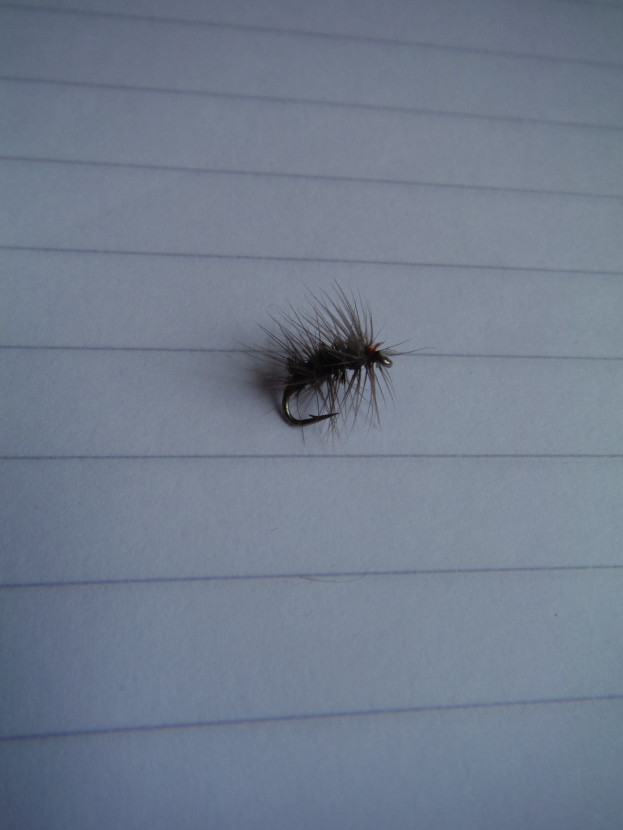 Grayling Steel Blue
Grayling Steel Blue November is the dark month, the sun now being too low to warm the water, and when accordingly grayling gradually lose the tendency to rise to the surface. Some would call that point the end of summer time, which is the last day of October this year, or perhaps Guy Fawkes night for those with happy childhood memories of November 5th bonfires. Obviously this will vary a little with the weather and in fact it’s very occasionally possible to find grayling coming up for hatching large dark olives on a warmish January afternoon. But it’s hardly something which anglers can reply upon and the main methods from November on will be heavy bugs trundled along the gravel using the various European close nymphing methods or trotting with a small worm or a couple of maggots. Wet flies will also be useful at times, possibly using patterns with lead under the dressing or a sinking leader butt section to gain some depth. Red Tag on the point, followed by Yellow Bumble and Grayling Steel Blue on the top dropper is a reliable cast for late autumn or winter. The combination was good enough for Reg Righyni and it has been kind to me at times.
Regular anglers will know that some winter grayling beats are traditionally fly only, while others allow trotting with a bait according to local regulations. One significant difference between the methods is that fly anglers are usually in the water and that those fishing nymphs usually wade quite extensively while searching the bottom. Obviously during the winter this implies a certain risk to redds of trout and salmon which will have been cut in the gravel by November or December. Anglers with trotting tackle, however, usually search the various swims from fixed positions and if necessary can work from the bank. It’s not always possible to see where the gravel has been disturbed, particularly when the water is coloured, and of course no responsible angler wants to go crunching around on fish eggs. Following the building of fish passes and other works on tributaries, particularly the Lugg, the electro-fishing results show that spawning salmon are accessing these gravels in increasing numbers. Accordingly the Foundation in combination with the owners have this year introduced some restrictions on beats which are regarded as potentially important salmon spawning locations; Eyton and Lyepole on the Lugg will be affected this year. I have had some great grayling sessions with nymphs on both those beats, but if more salmon are making it up there during the dark days of winter, then that seems to be altogether good news and I shall look forward to exploring them with the trotting gear for a change.
Tight lines!
Oliver Burch